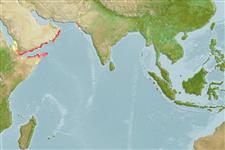>
Tetraodontiformes (Puffers and filefishes) >
Balistidae (Triggerfishes)
Etymology: Canthidermis: Greek, kanthos = the outer or inner corner of the eye, where the lids meet, 1646 + Greek, derma = skin (Ref. 45335).
More on author: Boulenger.
Environment: milieu / climate zone / depth range / distribution range
पारिस्थितिकी
समुद्री बेनथोपिलाजिक. Tropical
Indo-West Pacific: Red Sea, Arabian Sea, northern South China Sea, Japan and Micronesia.
आकार / वज़न / Age
Maturity: Lm ? range ? - ? cm
Max length : 60.0 cm TL पुल्लिंग / अलिंग; (Ref. 11441)
पृष्ठीय रीढ़ (सम्पूर्ण) : 3; पृष्ठीय सौफट रेज़ (सम्पूर्ण) : 23 - 26; गुदा कांटा: 0; ऐनल सौफट रेज़: 21 - 23. Caudal fin of adults double emarginate with produced lobes; juveniles with rounded caudal fin.
Enters the shallows to lay eggs in a nest in sand (Ref. 11441).
Life cycle and mating behavior
परिपक्व अवधि | पुनरुत्पत्ति | मछलीऔ का अंडे देना | अंडे | Fecundity | लार्वा
Randall, J.E., 1995. Coastal fishes of Oman. University of Hawaii Press, Honolulu, Hawaii. 439 p. (Ref. 11441)
IUCN Red List Status (Ref. 130435: Version 2024-1)
Threat to humans
Harmless
Human uses
साधन
Special reports
Download XML
इंटरनेट स्रोत
Estimates based on models
Preferred temperature (Ref.
123201): 21.7 - 26.5, mean 23.6 °C (based on 33 cells).
Phylogenetic diversity index (Ref.
82804): PD
50 = 0.6250 [Uniqueness, from 0.5 = low to 2.0 = high].
Bayesian length-weight: a=0.02692 (0.01267 - 0.05719), b=2.92 (2.74 - 3.10), in cm total length, based on LWR estimates for this (Sub)family-body shape (Ref.
93245).
Trophic level (Ref.
69278): 3.5 ±0.48 se; based on food items.
लौटाव (Ref.
120179): माध्यम, न्यूनतम जनसंख्या दुगनी होने का समय 1.4 - 4.4 वर्ष। (Preliminary K or Fecundity.).
Fishing Vulnerability (Ref.
59153): Moderate vulnerability (44 of 100).
